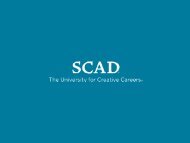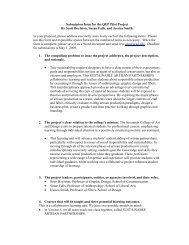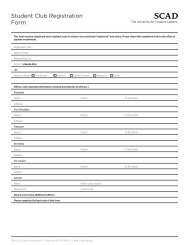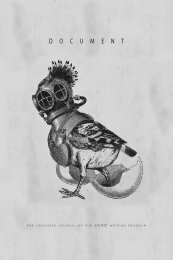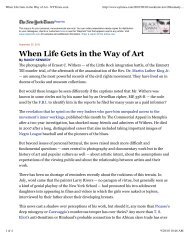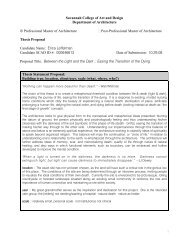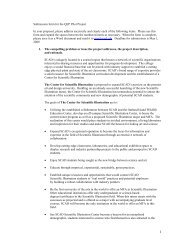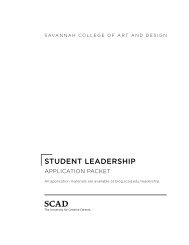Nicole Roberts MFA Thesis Visual Component Artwork - Savannah ...
Nicole Roberts MFA Thesis Visual Component Artwork - Savannah ...
Nicole Roberts MFA Thesis Visual Component Artwork - Savannah ...
You also want an ePaper? Increase the reach of your titles
YUMPU automatically turns print PDFs into web optimized ePapers that Google loves.
EXPECTATION 5 | multi-disciplinary approach<br />
Art & Design History<br />
10% 20%<br />
Supporting Design Disciplines<br />
Graphic Design Core<br />
35% 35%<br />
General Education<br />
16 Steven J. Teper, “The Creative Campus:<br />
Who’s No. 1,” The Chronicle of<br />
Higher Education, October 1, 2004.<br />
http://chronicle.com/article/The-<br />
Creative-Campus-Who-s/4870<br />
(accessed January 31, 2010).<br />
17 Daniel van der Velden, “Research<br />
& Destroy: A Plea for Design as<br />
Research,” Graphic Design Theory,<br />
2006. http://graphicdesigntheory.<br />
net/Velden.html (accessed February<br />
12, 2010).<br />
The average newly graduated graphic designer<br />
does not laud all that falls within their educational or<br />
occupational grasp. The twenty-first century has presented<br />
a more technological and more global industry than ever<br />
before. Pioneering designers are broadening their horizons<br />
into new dimensions, combating the ephemeral stigma<br />
of print, and integrating a multi-disciplinary approach<br />
to design, digital technology, product development,<br />
and the built environment. Students entering into<br />
the professional workplace see their career paths as<br />
graphic designers in a more fluid manner than collegiate<br />
design department names suggest. 16 Practitioners who<br />
capitalize on this philosophy distinguish themselves<br />
from more traditional design titles with specificity, such<br />
as environmental graphic designer, interactive space<br />
designer, network brand manager, or experience designer.<br />
Daniel van der Velden, Partner in the design research<br />
think tank Metahaven witnessed that “the ambition of<br />
the designer always leads beyond his discipline and his<br />
official mandate, without this above-and-beyond having a<br />
diploma or even a name of its own. Still, it is remarkable<br />
that design… enjoys far less respect than the combination<br />
of design and one or more other specialisms.” 17<br />
Van de Velden’s notion of ‘beyond the discipline itself’<br />
reinforces the need for multi-disciplinary knowledge.<br />
The term ‘graphic design’ exists today as a profession of<br />
pluralism, yet so often design education becomes insular<br />
in its process and methodologies. Many educational<br />
programs strive to further define individual disciplines,<br />
yet inadvertently create a void. After foundation studies<br />
design students are partitioned off, many find themselves<br />
enduring a multitude of projects, critiques, research, and<br />
theory, rarely crossing the paths of sister fields of design<br />
study. Naively, design students allow themselves to remain<br />
secluded, and mistakenly, collegiate administration fuels<br />
this divide by enabling curricula that does not require<br />
them to do otherwise.<br />
31




